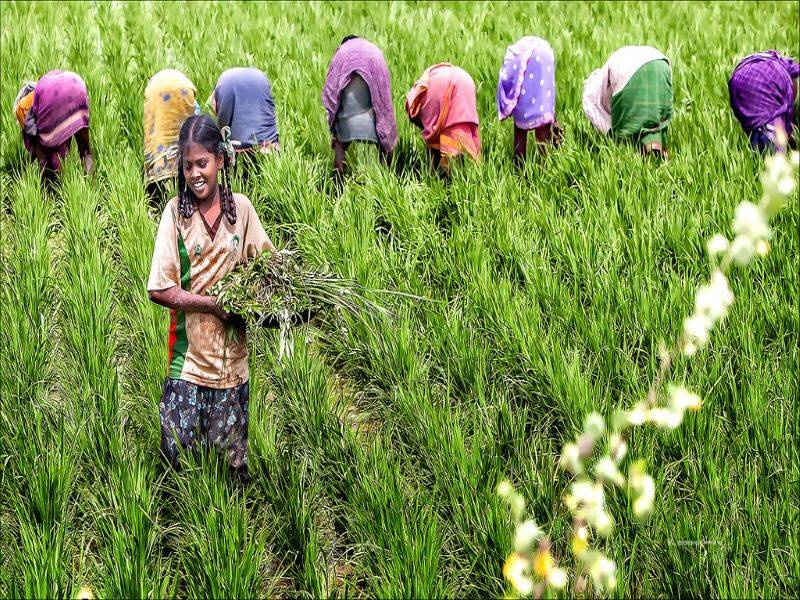
Serious weeds in Paddy fields are
Echinochloa colona and E. crus-galli are the most serious weeds affecting rice in all methods of rice establishment. E. colona requires less moisture than E. crus-galli resulting in the predominance of E. colona in dry-seeded rice.
Cyperus rotundus and Cynodon dactylon are other major problems in upland conditions, particularly in poorly managed fields.
Weedy rice is emerging as a major problem in direct-seeded rice.

Related Link
https://krishijagran.com/agripedia/paddy-cultivation-advisory-amid-covid-19/
Other weeds of major concern in Paddy fields include:
- Ammannia baccifera,
- Cyperus iria,
- Cyperus difformis,
- Eclipta alba,
- Fimbristylis miliacea,
- Ischaemum rugosum,
- Leptochloa chinensis,
- Monochoria vaginalis,
- Paspalum distichum and Spaenoclea zeylanica

Principles of weed management
- Adapt a weed management option that suits to the environment of the region, including soil, water, climate and biota present at the site;
- Optimize use of biological and chemical/physical resources for effective management of weeds in rice. Seed banks maintain emergent populations, therefore they must be managed at low densities to reduce the potential for a build-up of intractably high weed populations.

Related link
https://krishijagran.com/industry-news/acrenext-rice-farming-by-corteva-agriscience/
Important factors influencing the weed growth
- Rice seeding method
- Soil moisture
- Crop rotation,
- Type and amount of ferilisers applied,
- Time of fertilisers application,
- Rice cultivar,
- Water management;
- Crop management and weed control methods used.

Threshold levels for some weeds under transplanted condition are
- Cyperus iriaat density of 30 m–2 and
- Echinochloa crus-gallidensity of 20 m–2,
Integrated weed management – (Source: TNAU)
|
Critical period of weed control |
20-30 DAT |
|
Cultural method |
1. Hand weeding 2. Hand pulling 3. Pudding 4. Flooding |
|
Mechanical method |
1. Weeder (Float) 2. Conoweeder/Rotary weeder |
|
Chemical method |
1. Butachlor (1-2 kg ai/ha) 2. Alachlor (1-2 kg ai/ha) 3. Thiobencarb + 2, 4D 4. Isopropyl (0.75) ester (0.5 kg ai/ha) 5. Metsulfuron methyl (20 WP) (0.008 kg ai/ha) 6. Benthiocarb (1.5 – 2.5 kg ai/ha) 7. Propanil (2-3 kg ai/ha) (only post emergence) |
|
Biological method |
1. Hirsch – Manniella spinicaudata is a rice root nematode which controls most upland rice weeds 2. Azolla |
|
Remarks |
Substitution and preventive method: 1. Stale seed bed technology 2. Land preparation 3. Water management |

List of Herbicides banned by government in 2020 are:
- Butachlor,
- 2,4-D,
- Pendimethalin,
Cultural methods for weed management under different Rice-agroecosystems –
- Transplanted Puddled Lowland Rice –
- Use of rotary weeder from 15 DAT at 10 days interval.
It saves labour for weeding, aerates the soil and root zone, prolongs the root activity, and improves the grain filling though efficient translocation and ultimately the grain yield.
- Cultural practices like dual cropping of rice-azolla, and rice-green manure reduces the weed infestation to a greater extent.
- Summer ploughing and cultivation of irrigated dry crops during post-rainy periods reduces the weed infestation.
Dry-seeded Un-puddled Lowland Rice –
- First weeding can be done between 15 and 21 days after germination.
- Second weeding may be done 30 - 45 days after first weeding.
System of Rice Intensification –
- Using rotary weeder / Cono weeder / power operated two row weeder.
- Moving the weeder with forward and backward motion to bury the weeds and as well to aerate the soil at 7-10 days interval from 10-15 days after planting on either direction of the rows and column.
- Manual weeding is also essential to remove the weeds closer to rice root zone.
Conclusion
Paddy is one of the most important food grain crop in India. The production and productivity of rice defines the food security of the nation. Weeds are one of the major constraints in improving the paddy yields. Thus, proper weed management can aid in improving farmers income and saving food security of the nation.















